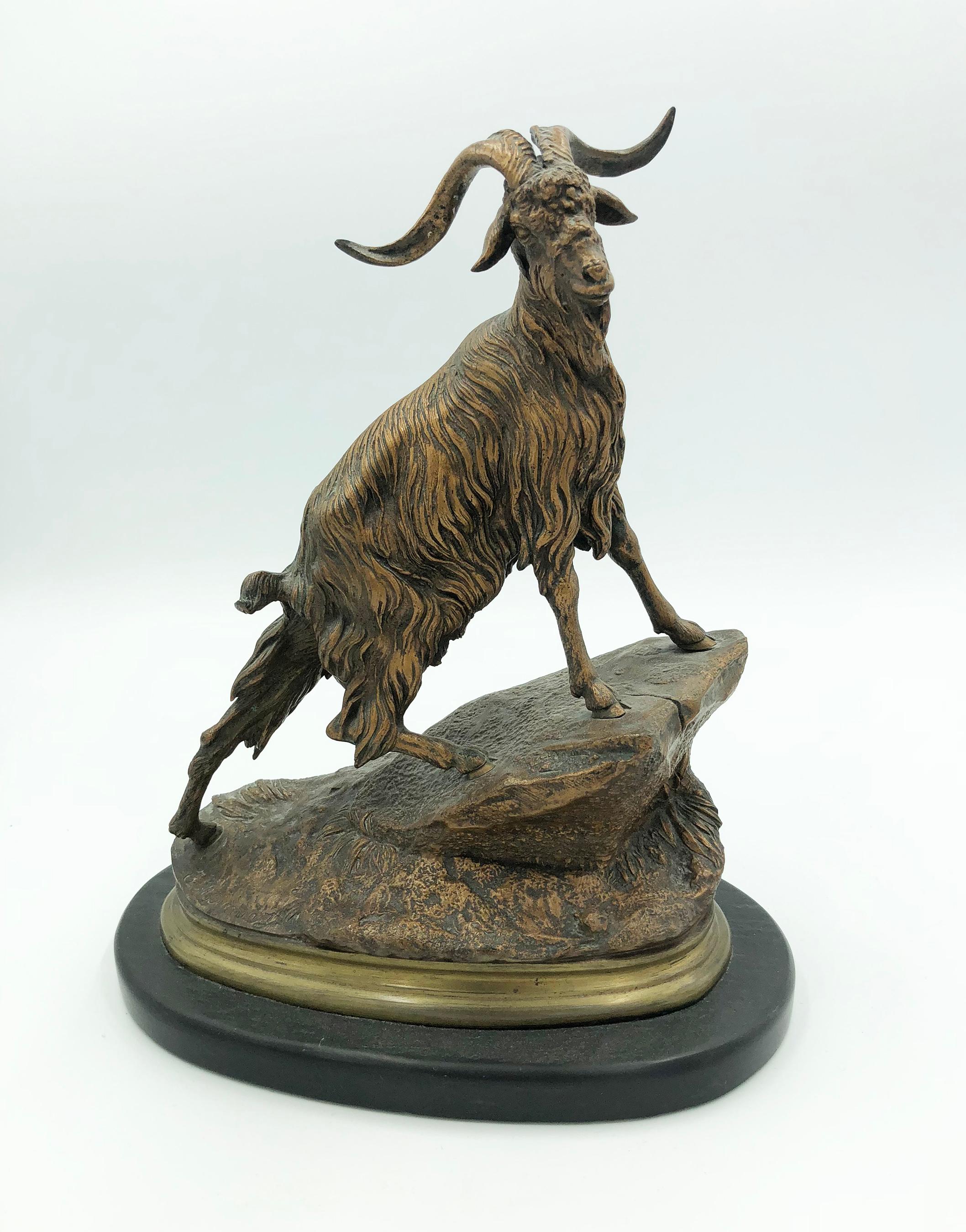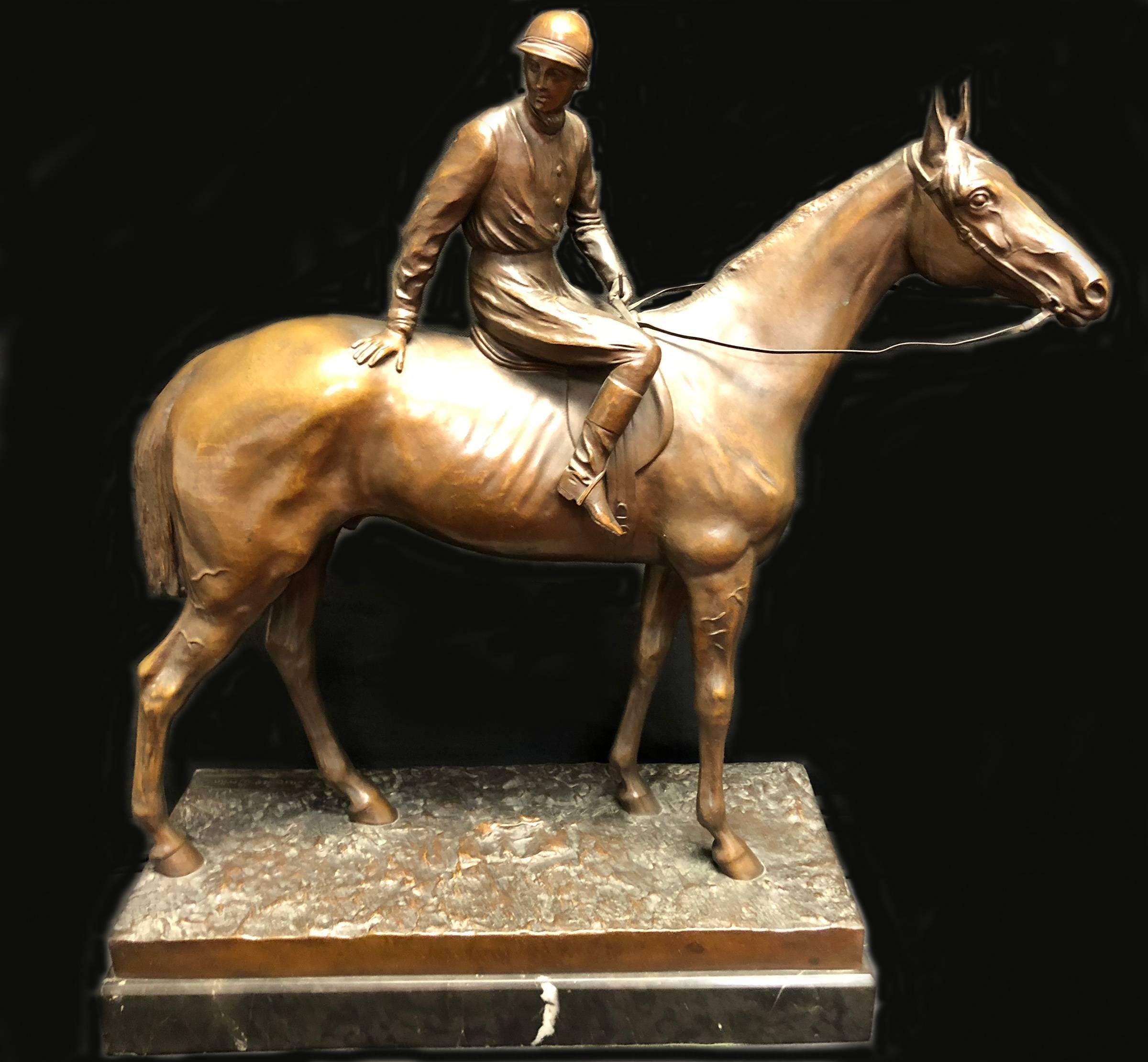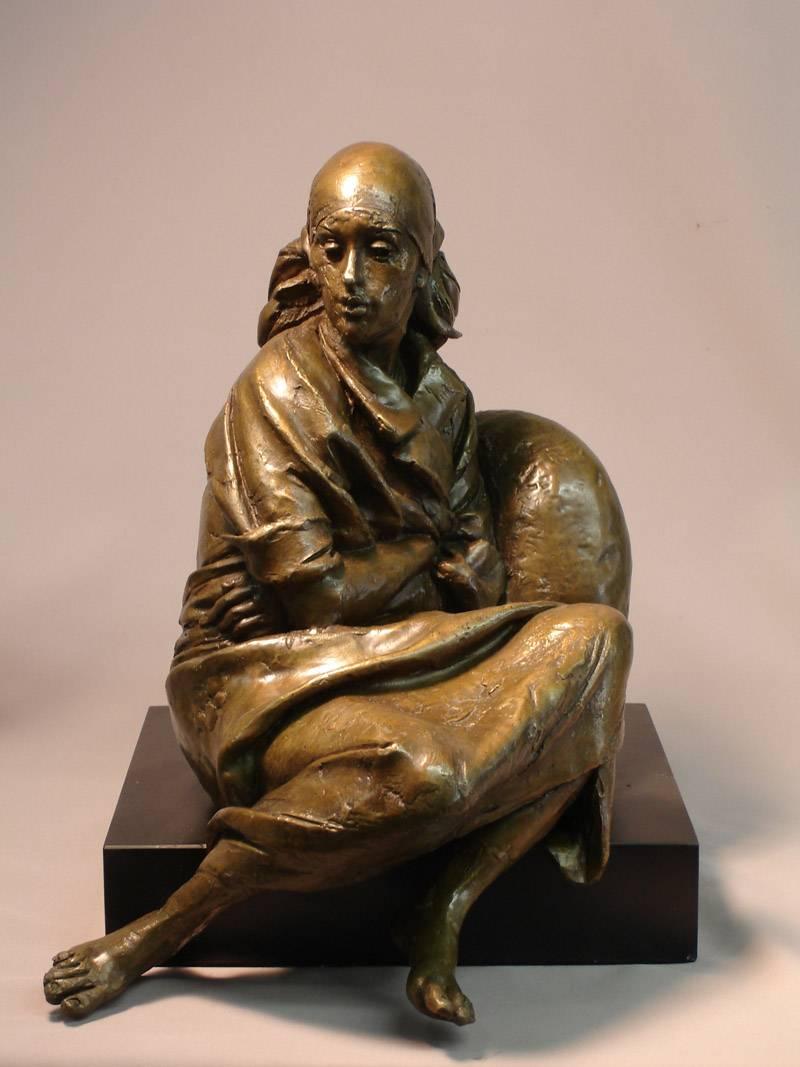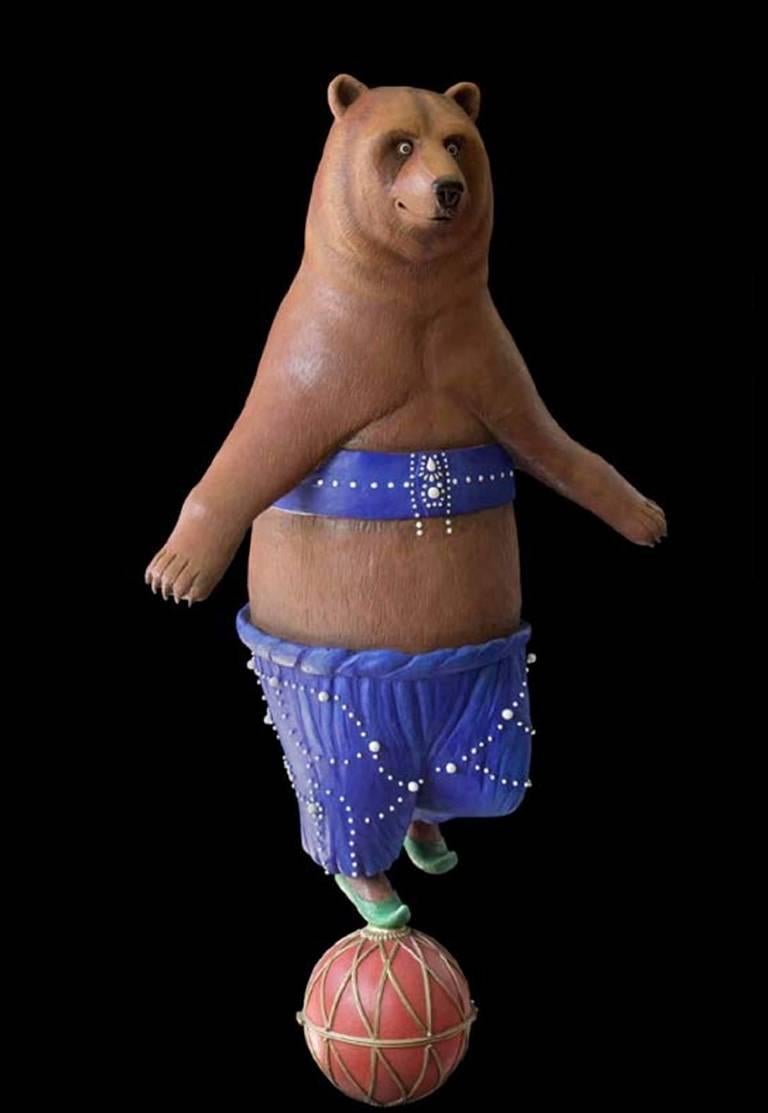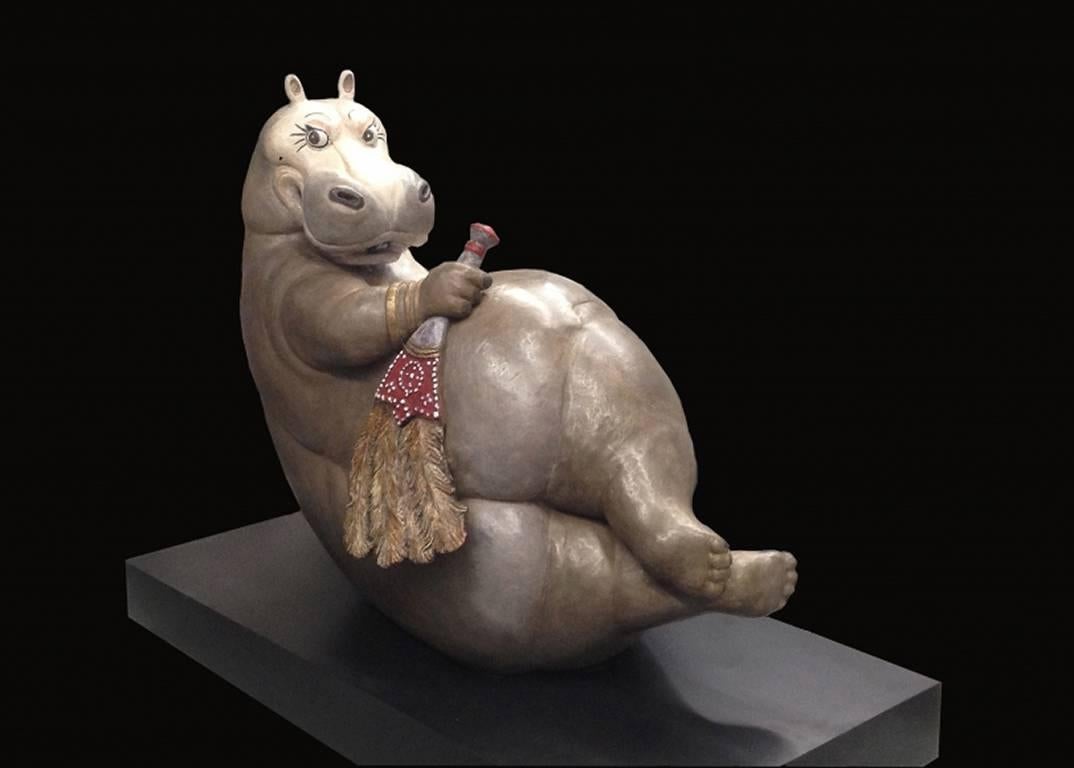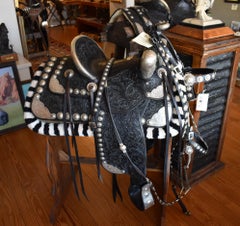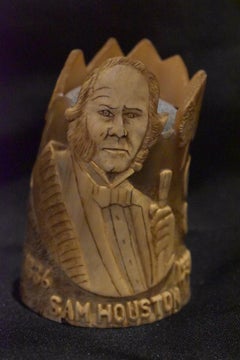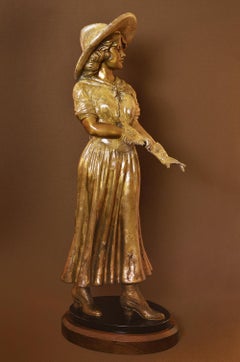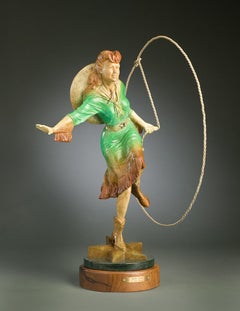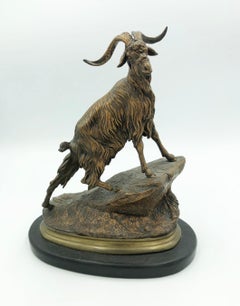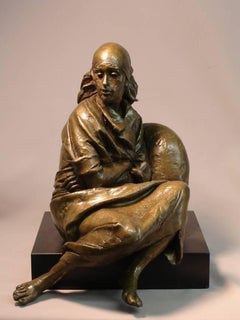Items Similar to " THE LAST DROP " Charles Schreyvogel (1861-1912) BRONZE SCULPTURE 1903 WESTERN
Want more images or videos?
Request additional images or videos from the seller
1 of 10
Charles Schreyvogel" THE LAST DROP " Charles Schreyvogel (1861-1912) BRONZE SCULPTURE 1903 WESTERN1903
1903
About the Item
Charles Schreyvogel
(1861-1912)
New York / New Jersey Artist
Image Size: 12" x 18.50" x 5"
Medium: Bronze Sculpture
1903
"The Last Drop"
Charles Schreyvogel (1861-1912) New York / New Jersey Artist
One of the better-known painters of Western subject matter, Charles Schreyvogel was especially interested in military life in the days of the disappearing frontier. His western scenes were usually subjects with landscape as the backdrop, and his depictions of Indians were that of people with dignity and pride. "His favorite theme was warfare between intruding whites and Indians defending their ancestral homelands." (Baigell, 321)
He spent most of his life as an impoverished artist and then earned what seemed like overnight fame. "When Remington died in 1909, Schreyvogel wore the mantle of premier Western artist for the brief remainder of his life." (Zellman, 557)
Schreyvogel was born in New York City and grew up in a poor family of German immigrant shopkeepers on the Lower East Side and also spent much of his childhood in Hoboken, New Jersey. He found work in art-related trades including as a Meerschaum pipe carver, goldsmith, and lithographer.
He taught himself to draw, but he studied with H. August Schwabe at the Newark Art League. By 1880, he was teaching drawing and painting and used the roof of his apartment in Hoboken as his studio. In 1887, with the help of several patrons, especially Dr. William Redwood Fisher, he went to Munich, Germany for three years and studied with Carl Von Marr and Frank Kirchbach. Dr. Fisher encouraged the artist to take an interest in western subject matter.
Returning to the United States, he had bad health and was advised to go West to regain strength, but he didn't have the money for several years so he satisfied his aroused interest by sketching cowboys and Indians he saw in Buffalo Bill's Wild West Show.
In 1893, Schreyvogel first went West, visiting Arizona and the Ute Reservation in southwest Colorado. He quickly regained his health and excelled as a horseman. He also learned sign language to communicate with the Indians to persuade them to pose for him. But the resulting paintings didn't sell in the East, so he, having married Louise Walther, earned money with portrait painting of miniatures on ivory while continuing to do western painting.
In the 1890s and 1900s, he made additional trips West, including the Blackfeet Reservation in Montana. In 1901, his work, My Bunkie, won the first-place honor, the Thomas B. Clarke Prize, at the National Academy of Design, and a market for his western paintings and sculpture was set. My Bunkie was a rejected painting that even his local cafe owner had refused to hang, and despairing, he had left it at the Academy. He was so sure he would get no recognition that he had not even bothered to leave his address.
He worked from studios in Hoboken, New Jersey, and from a farm in West Kill, New York, and his Academy success was followed by winning a bronze medal in Paris and another at the Pan-American Exposition in Buffalo.
The money he earned from this recognition allowed him to do more traveling in the West where he gathered material for his studio painting, many of them military scenes. Most of his canvases were large, but he was such a meticulous painter that he only completed about seventy-five western paintings. He also did some watercolors, and many of his paintings were reproduced during his lifetime.
He died in Hoboken from blood poisoning from a chicken bone lodged in his gum. His studio and collection are on permanent display at the Cowboy Hall of Fame in Oklahoma City.
Sources:
Peter Hastings Falk, Editor, Who Was Who in American Art
Matthew Baigell, Dictionary of American Artists
Michael David Zellman, 300 Years of American Art
CHARLES SCHREYVOGEL (1861-1912)
Literature:
J.D. Horan, The Life and Art of Charles Schreyvogel, New York, 1969, page 55.
Charles Schreyvogel was born in New York City in 1861 the son of migrant Germans bound and determined to make America their new home following departure from a tumultuous Europe and, specifically, Germany. His father, Paul, and mother Teresa Erbe Schreyvogel were shopkeepers in New York's lower east side. Charles was the second of three sons born in the family and from his early years in the public schools he surprised his teachers with delightful sketches.
These were the predecessors to his fervent desire to become an artist, an avocation that his prosperous, merchant father found little favor with. He was not to denied and early exposure to August Schwabe, a dedicated fan of the arts and struggling artists, and later to Dr. William Redwood Fisher, led to study in Europe at the Munich Art Academy with Karl von Marr and Frank Kirchback.
Charles Schreyvogel eventually became one of the most popular artists ever to depict the American West in paint and bronze. His early life of struggle with poverty and health led to an ever-present desire to excel. His first national recognition came from a first prize in the 1900 National Academy Exhibition with his entry, My Bunkie. Numerous works were reproduced as lithographs, gravures and platinum prints. The Duel is one such work to have been reproduced.
His extensive forays to the west resulted in field sketches that were used in his Hoboken, New Jersey studio to depict some of the most popular renditions of American cavalry officers and their Indian adversaries. His highly publicized debate with the very popular, and jealous, artist, Frederic Remington, over the authenticity of the ingredients and the scene depicted in his painting, Custer's Demand resulted in an outpouring of support from relatives and friends of Custer: his widow, Elizabeth, President Theodore Roosevelt and Col. J. S. Crosby, himself depicted in the work. His place in history was firmly established by his expertise and talent.
His works are scarce and sought after. Fewer than one hundred paintings are known to have been recorded due to his limited output and short life span. His works are held sparingly by major museums and collections worldwide.
Charles Schreyvogel was born in New York City in 1861 and died in Hoboken, New Jersey in 1912. A poor boy on the east side of New York City, Schreyvogel sold newspapers and worked as an office boy while being educated in the public schools. When his parents moved to Hoboken, he carved Meerschaum and was apprenticed to a gold engraver, then became a die sinker, and finally, in 1877, a lithographer.
By 1880, he was a lithographic artist and teaching drawing. By 1887, he had patrons enabling him to study in Munich for three years, the pupil of Carl Marr and Frank Kirchbach. When he returned, he existed as a lithographic artist while unsuccessful with portraits, landscapes, and miniatures on ivory. After sketching the Buffalo Bill Show personnel in New York, he was able to spend 1893 in the West.
For five months, he sketched in Colorado at the Ute Reservation, then went to Arizona to sketch the cowboys. When he came back to Hoboken with a collection of gear, he continued as a lithographic artist while his paintings of Western Army life did not sell. One of these paintings was My Bunkie, which he could not dispose of either as a painting or for lithography in 1899. Offered to a restaurant on consignment, it was hung in a dark corner, so Schreyvogel took it back and entered it in the 1900 National Academy exhibition without leaving his address. When My Bunkie won the highest prize of $300.00, no one at the Academy had until then heard of Schreyvogel or knew where he lived.
Immediately successful, Schreyvogel went West again in 1900, sketching troopers and Indians in the Dakotas for the series of paintings on the Western Army. In 1903, Remington who was the most important Western illustrator called Schreyvogel's work "half-baked stuff", but the soldiers depicted spoke up for him. His output was limited to relatively few major works per year because of the number of his research trips and the size of the paintings, but reproductions were widely published. One set of these was in the form of "platinum prints," that is, large photographs.
When he died in 1912 from blood poisoning after a chicken bone stuck in his gum, he left relatively few Western oils. There were also left clay models that were later cast into bronze.
Charles Schreyvogel was Frederic Remington's chief rival during the early years of this century, when interest in artistic depiction of the West was very high. Unlike Remington, Schreyvogel never worked as an illustrator, seeking instead to establish his reputation as an academic artist.
He was born in New York City and in 1886 went to Germany to study at the Munich Academy. Returning to America, he set up a studio in Hoboken, New Jersey, which was then a rural town surrounded by fields and marshlands. Almost immediately he became friends with Nate Salisbury, Buffalo Bill Cody's energetic manager for the Wild West Show, and Schreyvogel spent many hours sketching the Indians and cowboys whom he saw there.
In 1893 Schreyvogel journeyed to the Ute reservation at Ignacio, in the southwestern corner of Colorado. There he observed the Apache, Navajo, Utes, and other tribes who came to receive their government allotments, and he listened to their stories of the Plains Indian wars. He collected great quantities of artifacts, including full costumes and uniforms, which he later utilized in paintings. Returning to Hoboken, Schreyvogel decorated his studio with memorabilia and photographs, and set to work methodically depicting the events of the Indian wars at the close of the frontier period.
The artist researched his subjects painstakingly through various methods of clay modeling and employing live models, prior to transferring their likenesses onto canvas. This enabled Schreyvogel's details to be carefully delineated and subordinated to the whole, which lent itself to telling the story in a complete and cohesive manner. "He is more than a historian of the Indian," one writer observed during the artist's lifetime. "He is giving us an invaluable record of those perilous days of the western frontier when a handful of brave men blazed the path for civilization and extended the boundaries of empire for a growing nation." These words were written after the death of Remington in 1909, when Schreyvogel was proclaimed "the greatest living interpreter of the Old West."
ReSources include: The American West: Legendary Artists of the Frontier, Dr. Rick Stewart, Hawthorne Publishing Company, 1986
Charles Schreyvogel worked as an apprentice to a gold engraver as a young boy and later became a die sinker. In 1877 he tried to earn income as a lithographer, but his lifestyle remained quite meager. He attended the Newark Art League and studied with August Schwabe and then went to the Royal Academy in Munich from 1887-90. He enjoyed painting Western scenes and was able to travel West due to the patronage of W.R. Fischer. While on his trip, Schreyvogel sketched in Colorado and Arizona. He made a second trip west in the same year to sketch troopers and Indians in the Dakotas for a series on the Western Army.
His work did not sell until he entered a painting from his travels, "My Bunkie", into the National Academy of Design exhibition in 1900. He won first prize and gained sudden success at the age of 40. "My Bunkie" is a dramatic Western scene of a cavalryman rescuing an unhorsed comrade from pursuing Indians. Schreyvogel was favorably compared with Frederic Remington, another Western genre painter. "Custer's Demand" (1903) received critical acclaim for its composition, drama and sense of color. Numerous works were reproduced and garnered a large following.
Schreyvogel died in 1912 of blood poisoning and left fewer that 100 known paintings.
- Creator:Charles Schreyvogel (1861 - 1912, American)
- Creation Year:1903
- Dimensions:Height: 12 in (30.48 cm)Width: 18.5 in (46.99 cm)Depth: 5 in (12.7 cm)
- Medium:
- Movement & Style:
- Period:
- Condition:Please view my other items. We have a large amount of Vintage Texas & American Paintings, Landscapes, Westerns, Mid Century. Also a large selection of Vintage Bohlin Parade Saddles.
- Gallery Location:San Antonio, TX
- Reference Number:1stDibs: LU769315482802
About the Seller
5.0
Vetted Professional Seller
Every seller passes strict standards for authenticity and reliability
Established in 1974
1stDibs seller since 2017
95 sales on 1stDibs
Typical response time: 1 hour
- ShippingRetrieving quote...Shipping from: Fredericksburg, TX
- Return Policy
Authenticity Guarantee
In the unlikely event there’s an issue with an item’s authenticity, contact us within 1 year for a full refund. DetailsMoney-Back Guarantee
If your item is not as described, is damaged in transit, or does not arrive, contact us within 7 days for a full refund. Details24-Hour Cancellation
You have a 24-hour grace period in which to reconsider your purchase, with no questions asked.Vetted Professional Sellers
Our world-class sellers must adhere to strict standards for service and quality, maintaining the integrity of our listings.Price-Match Guarantee
If you find that a seller listed the same item for a lower price elsewhere, we’ll match it.Trusted Global Delivery
Our best-in-class carrier network provides specialized shipping options worldwide, including custom delivery.More From This Seller
View AllEDWARD BOHLIN 1920s-1930s SILVER ART PARADE SADDLE HOLLYWOOD WESTERN ARTIST VAIL
By Edward H. Bohlin
Located in San Antonio, TX
Circa Late 1920s - Early 1930s. It is all Bohlin made and marked to include the saddle, the headstall and the breast collar. All made in Hollywood California. The only non-Bohlin ite...
Category
1930s Realist More Art
Materials
Silver
"SAM HOUSTON" HORN CARVING 1936 TEXAS CENTENNIAL AMAZING WORK
Located in San Antonio, TX
Dan Super "SAM HOUSTON"
(1873-1953)
Houston Artist
Image Size: 3 3/4 inches tall
Medium: Carved Horn of Sam Houston to celebrate the Texas Centennial.
Texas Centennial 1936
"Sam Houston Pin Cushion Holder"
Biography
Dan Super (1873-1953)
Dan E. Super, Jr. (1873 – 1953) Dan Super had the eye of a sculptor, envisioning and then creating hundreds of objects from the elongated form of a Texas Longhorn’s tusk. At the age of six, Dan Super carved his first drawing into a piece of the horn of a Texas Longhorn. Over the next 56 years, he made utilitarian pieces like pencil cups, pin cushions, and backscratchers, realistic replicas of animals and birds, and imaginative carvings of elegant nudes. While these carvings resemble the traditional art of scrimshaw, carvings from whale bone, we’ve not been able to identify another carver who used the Texas Longhorn as his material. “My work is done with an ordinary pocketknife, hacksaw file and rasp,” Super wrote in 1937. He used the horn in every way conceivable; whole, allowing the shape to define the object he was making, flattened to make mosaic or inlay work. He incised and pierced it and carved in the round. His own hands polished the horn to a sheen. Daniel Super, Jr. was born in Houston on August 22, 1873. His father owned stock years, D. Super and Brothers Co., providing the young Super with ready access to his raw material. Throughout his life, he worked in the businesses key to the identity and success of young, booming Houston, cattle, oil, real estate and rail. In 1896 he married Lula, and took over the family business, expanding it to include a grocery. He closed the company in 1912 and got into the oil business...
Category
1930s Realist Figurative Sculptures
Materials
Other Medium
"WILLOW" BRONZE SCULPTURE
Located in San Antonio, TX
John Bennett
(Born 1952)
Fredericksburg, Texas Artist
Image Size: 36 tall x 13 x 14
Medium: Bronze
"Willow"
John Bennett (Born 1952)
John Bennett was designated Texas State Artist 20...
Category
20th Century Modern Figurative Sculptures
Materials
Bronze
"BELLE STARR" BRONZE SCULPTURE
Located in San Antonio, TX
John Bennett
(Born 1952)
Fredericksburg, Texas Artist
Image Size: 25 x 18 x 4
Medium: Bronze
"Belle Starr"
John Bennett (Born 1952)
John Bennett was designated Texas State Artist 201...
Category
20th Century Modern Figurative Sculptures
Materials
Bronze
"FRANK REAUGH" PALLET BRONZE DATED 2014 1/30 TEXAS ARTISTS, SCULPTOR & SUBJECT
Located in San Antonio, TX
Garland Weeks
(1942-Present)
Lubbock Artist
Image Size: 12 x 9
Frame Size: 17 x 14
Medium: Bronze
2014
"Frank Reaugh" Bronze Relief Pallet depicting Frank Reaugh at his easel.
Category
2010s Impressionist Figurative Sculptures
Materials
Bronze
"MAIDEN'S HONOR" ZUNI BRONZE SCULPTURE
Located in San Antonio, TX
John Bennett
(Born 1952)
Fredericksburg, Texas Artist
Image Size: 14 Tall x 7 x 7
Medium: Bronze Sculpture
"Maiden's Honor" Zuni
John Bennett (Born 1952)
John Bennett was designated ...
Category
20th Century Modern Figurative Sculptures
Materials
Bronze
You May Also Like
Mountain Goat
By Jules Moigniez
Located in Missouri, MO
Jules Moigniez
"Mountain Goat"
Bronze
approx 11 x 9 x 4 inches
Signed
Jules Moigniez (1835-1894)
Jules Moigniez was born in Senlis sur L'Oise, France ...
Category
1870s Realist Figurative Sculptures
Materials
Bronze
Jockey On Horseback
By Hans Guradze
Located in Missouri, MO
Hans Guradze (German, 1861-1922)
"Jockey On Horseback"
Bronze
Approx. 19.5 x 17 x 6 inches
Signed "H. Guradze Berlin" on Base
Category
1890s Realist Figurative Sculptures
Materials
Bronze
Price Upon Request
Resting
By Bruno Lucchesi
Located in Greenwich, CT
Ed. 2/6.
Bronze sculpture by Bruno Lucchesi of a woman sitting.
Category
1970s Realist Figurative Sculptures
Materials
Bronze
$14,000
Native American On Horseback Bronze Sculpture Daro Flood
By Daro Flood
Located in Norwood, NJ
Native American on horseback. Signed and numbered 24/30, artists cypher.
Daro Flood (1954 - 2017) was active/lived in Arizona. Daro Flood is known for Portrait bust Indian and cowboy sculpture...
Category
Late 20th Century Realist Figurative Sculptures
Materials
Bronze
Dancing Bear
By Bjørn Okholm Skaarup
Located in Greenwich, CT
Ed. 1/6.
Bronze sculpture by Bjorn Skaarup of a bear dancing on a ball.
Category
2010s Realist Figurative Sculptures
Materials
Bronze
Price Upon Request
Hippo Odalisque
By Bjørn Okholm Skaarup
Located in Greenwich, CT
Ed. 4/6.
Bronze sculpture of a hippo by Bjorn Skaarup, inspired by Ingres's Grande Odalisque.
Category
2010s Realist Figurative Sculptures
Materials
Bronze
Price Upon Request
Recently Viewed
View AllMore Ways To Browse
Antique European Sculpture
Large Entry Sculpture
Antique Bronze Sculpture Signed Art Sculptures
Antique Bronze Sculpture Artists
Money Sculpture
Charles Page
Antique Western Signs
Antique Cowboy
Chief Sculpture
The Boy Bronze Sculpture
90s Bronze
Reproduction Bronze Sculpture
Bronze Pan
Antique Colorado
Miniatures On Ivory
1900s Bronze Sculpture
Antique Gold Pan
Bronze Bone
